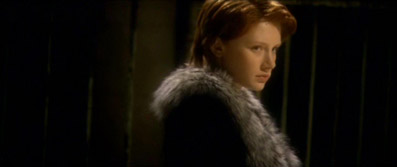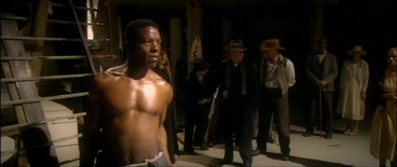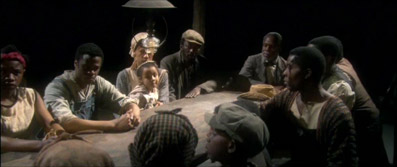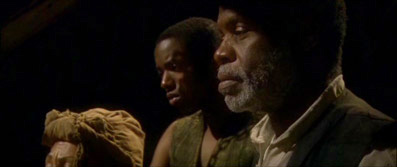This
review contains a major spoiler, which is indicated
in advance for those who have not yet seen the film.
2003
saw the release of Lars von Trier's eagerly awaited follow
up to Dancer
in the Dark (2000), Dogville.
The first part in his 'U.S.A – Land of Opportunities'
trilogy, it showed a groundbreaking minimalist use of film
form, not seen outside of avant-garde Brechtian cinema,
as well as his trademark female protagonist, played by his
biggest star yet, Nicole Kidman. There was a great amount
of critical noise surrounding this picture at the time of
its release, not in any small part due to the fact that
this crazy Dane had managed to snag a Hollywood sweetheart
for his lead role. The less cynical of us may prefer to
think it was because of his reputation as one of independent
film's most creative and challenging auteurs.
What
is of no doubt is that Dogville, as did
The Idiots (1998) before it, has reinvented
the wheel. Lars had done it again, dissected the technique
of film and reassembled it as his own. There were elements
of the Dogme 95 manifesto that The Idiots
adhered to so religiously; handheld camera, breaking the
180 degree rule (line of action), jump cutting etc, as was also
the case with Dancer in the Dark. But what
Dogville did was take this a step further.
Here you are watching the characters, the acting, solely.
Every aspect of Dogville's sparse layout
is constructed to maximise exposure of the characters.

All
of this has to be said in order to lay foundation for a
decent analysis of Manderlay (2005), as
indeed one needs to have experienced Dogville
in order to get the most out of its sequel.
Both
films are allegories for modern America and its politics
as well as a dramatised interpretation of early 20th century
regional America. Dogville's poor small
town represents a herd mentality, with the liberal leanings
of Tom eventually quashed by his need for community, whereas
Manderlay is set in a more historically
specific place and time, Alabama, post slave abolishment.
Here the coloured folk of the village, still under slave
conditions, are set free, although have a hard time adjusting
to their freedom.
What
ties the two films together is our trilogy protagonist and
backbone to its stories, Grace. A slave to the people of
Dogville in the first film, her role is reversed in Manderlay,
as she takes on the position of Liberator after resting
on the doorstep of the village with her father's convoy
of gangsters, on their way home. Immediately comparisons
to recent U.S. politics can be seen in this 'liberation',
which will be discussed later. I
feel although this is the barest of synopses this article
is meant for those already familiar with these films, so
it should suffice, to make room for the real discussion
points of such great work.
Von
Trier uses Grace as a multi-purpose tool. She is a catalyst
for the communities she comes into contact with in both
movies, she is von Trier himself; an outsider to foreign
ways, and she is a growing and very human character. It
is her journey that the audience invests in, and be it allegorically
or humanistically, she is who we must identify with in order
for these films to work. von Trier has had much practice
in creating a believable and sympathetic leading lady as
his last three films previous to the trilogy concerned central
female characters. With Dogville he put
this experience to great effect, and Kidman's performance
is arguably the best of her career (and definitely the most
vulnerable). So the first question I ask of Manderlay,
a film that in the same way to its predecessor relies so
strongly on its characters, is; with the absence of Kidman
how does the character of Grace hold up?

To
answer this we must look at Nicole's successor, Bryce Dallas
Howard, the daughter of celebrated gingernut actor and prolific
director/producer Ron (The Da Vinci Code)
Howard. Yes, this put me off her too, to start with. Also
her acting history doesn't look too impressive, with M.
Night Shyamalan's The
Village (2004) the only major credit to her
name. Any doubt was dispelled however in five minutes of
her performance. It is after establishment of the townsfolk
of Dogville when Grace makes her first appearance. What
is different in Manderlay's beginning sequence
is the immediate inclusion of our protagonist. It is clear
Howard plays a different Grace, a younger Grace, though
in no way an immature or weak Grace. This is a person who
has been reborn from her past experience and is ready to
use her new power for forces much better than her father's.
This second Grace is someone who has developed from Dogville,
though still bears a good willed naivety, meekly channelled
by Howard. Her father in Manderlay has
also changed, from James Caan to Willem Dafoe. A new father
for a new daughter, and the pair spark wonderfully in the
few scenes they share, early in the film.
There
are a good deal of familiar faces from Dogville
here too, although morphed into different roles. For example
Lauren Bacall returns as the character of Mam, Chloe Sevigny
and Jeremy Davies have to make do with minor roles, whereas
Trier regulars Udo Kier and Jean-Marc Barr have larger ones
as Grace's father's gangsters assigned to help enforce her
new laws. All of these performances are as competent as
ever, but the one supporting role that really shines through
is that of Danny Glover. He plays Wilhelm, Mam's old and
loyal slave, with a sensitivity it would seem von Trier
can bring out of any Hollywood standard. For a director
famed for his disliking of actors, Lars von Trier gets the
most naturalistic performances from his cast since John
Cassevetes. Of course one could argue a realism to his work.
Although the depths of such an argument are not suited for
this review, I will just comment that personally I believe
there to be a truth to these films just as honest as his
movies of the Dogme era, despite their theatrical mise-en-scene.
Both
Glover and Howard, together with the writing and structure
of this picture, bring a more solid and accessible story
to the screen than that of Dogville, which
is surprising considering the lesser known lead. Saying
this I take nothing away from the original, which has the
raw vitality of something new and exciting, as is Trier's
way. Unfortunately this freshness in not so clear in the
sequel, for obvious reasons. The style and technique remains
from Dogville, with the odd change. Manderlay
is a darker picture aesthetically, as there is a constant
black backdrop without the white backgrounds that connoted
daytime in Dogville. This creates an altogether more claustrophobic
atmosphere, even though the set is quite a bit larger. It
is also interesting that while there is a darker mise-en-scene
in Manderlay there is a lighter tone to
much of the film. There are a few humorous scenes and much
of the score has optimism, although I am suspicious that
this is meant with a tinge of irony, in the same way as
John Hurt's voice over (one constant throughout the trilogy
I would expect).

Once again the format for the picture is High Definition
video, and the quality is very close to film. The problem
with contrast (heightened by such basic lighting and set)
has been well kept in check by Anthony Dodd Mandle, Trier's
long time DP. One must be especially thankful of this, as
contrast plays such a large role in the aesthetics of the
film; the juxtaposition between white and dark skins a paradigm
for much of Manderlay's meaning.
The
following paragraph reveals a key plot develoment
– click here to bypass |
Although
it is all too easy to get caught up in obvious and immediate
meaning such as racism and class struggle that adorn this
sequel, it is important to keep in mind the film as a second
act to a three part whole. As previously mentioned, Grace
is in many ways von Trier himself, on a journey throughout
these alien lands, and the development of the character
shows Trier's ever conflicting opinions on American society
and politics. It is a shallow critic who looks upon this
film as nothing but a criticism of America. From Grace it
shows a misplaced, though well intentioned, psyche, still
young and naïve, yet learning. Grace through her troubles
grows as a person, as America grows as a country. She makes
mistakes and learns from them. Idealism becomes pragmatism
with the seemingly necessary death of Old Wilma. By the
end of Manderlay she knows not to force
'liberation' (her ideal) on a community, and this is where
the importance lies. Lars von Trier is saying that after
Iraq Bush should learn from his mistakes and not provoke
a people, even a world, to rise up against him as the people
of Manderlay did to Grace.
It would be wrong to directly compare
Manderlay to its predecessor, and would
belittle von Trier's vision to do so, although inevitably
comparisons will be made. I think it is clear that the crew
have learnt some practical lessons in this format since
Dogville, as the sets and lighting are
used to greater effect on occasion and CGI is used sparingly
and is flawless in its suitability.
Manderlay
stands on its own two feet as another Lars von Trier masterpiece,
although is really just a part of an as yet incomplete whole.
Shot
on High-Def but framed once again 2.35:1, the transfer here
is of a very high order, with crisp detail and accurate
colour reproduction (the brownish hues were how the film
played on the cinema screen). The contrast is excellent,
with the large areas of background black rendered perfectly
without sacrificing any foreground detail. Shadow detail
is very good. There are some minor compression artefacts
visible on the top shots, but on the whole this is a very
good transfer.

Both
stereo 2.0 and surround 5.1 tracks are available. The 5.1
track is a little fuller than the stereo track – seperation
is good on both, but little use is made of the rears on
the surround track. Clarity is very good, given the occasional
limitations imposed by the sound stage.
This
DVD, as with the UK release of Dogville,
is not laden with extras, although it does boast a commentary
with cinematographer Anthony Dodd Mantle and Lars von Trier
himself. It is an informative feature with Dodd Mantle making
many of the articulate statements. This is because English
is not the first language of the director and the British
Mantle, a long time collaborator with Trier, helps him along
with translating some observations. He also acts as an interviewer
and his relationship with Lars is instrumental in probing
him for information he may not have given if left to his
own devices. Mantle, as one would expect, is mostly concerned
with the technical aspects of production. There is much
talk of lighting and camera use, how the HD video coped
with the minimalist aesthetic etc. Von Trier is impressively
self critical and there is no trace of the ego more mainstream
directors often impress upon commentaries. He admits lessons
learnt from Dogville, although thinks that
the editing may have been too narrative driven, and could
have done with more space for the characters to breathe.
There is a humanistic debate that skirts on the fringes
of being extremely interesting; ideas on Grace's primitive
sexual wants are contrasted against her ideological needs,
but much of this is lost in Trier's caginess or maybe protectiveness
to the films ambiguity. All in all though, it is a worthwhile
addition to the release, and one that would have improved
Dogville's.
The
second extra is a 40 minute making of documentary entitled,
The Road to Manderlay. Consisting
of interviews and on-set and behind-the-scenes footage,
it is a good companion piece to the commentary, giving insight
into what a von Trier set can be like, and what it's like
to work with him and his untraditional techniques.
Last
on the special features is the usual bit of fluff to bulk
the product out; a theatrical trailer.
This unremarkable trailer hints at the main theme of the
movie without giving too much away. I'm not really a trailer
man though, so perhaps not best suited to comment on its
shortcomings, but I am of the school of thought that believes
such an extra lends little to the attraction of the overall
package.
A
mesmerising and worthy successor to Dogville,
Manderlay ticks all the boxes expected
of the Danish maestro, and leaves us salivating with anticipation
over the final instalment of his trilogy. With regards to
the extras, not a dazzling array of features, but the commentary
and featurette are good enough to warrant a thumbs up. I
suppose it is what one must expect when dealing with one
of world cinema's most enigmatic and inspired characters.
|